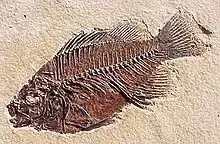| Cockerellites Temporal range: Early Eocene, ~ | |
|---|---|
 | |
| Specimen of C. liops from the 18 inch layer of the Green River Formation, Wyoming | |
| Scientific classification | |
| Kingdom: | |
| Phylum: | |
| Class: | |
| Order: | |
| Family: | |
| Genus: | †Cockerellites Jordan & Hanibal, 1923 |
| Binomial name | |
| †Cockerellites liops (Cope, 1877) | |
| Synonyms | |
| |
Cockerellites is a genus of extinct temperate bass[1] described from early Eocene-aged fossils found in the Green River Formation of Wyoming.[2][3] It is characterized by a sunfish-like body and its stout dorsal and anal spines. The type species, C. liops, was originally named as a species of Priscacara by Edward Drinker Cope upon creating the genus in 1877,[4] but P. liops was moved to the newly created genus Cockerellites by D. Jordan and H. Hanibal in 1923.[5] Some authors, such as Whitlock (2010), still consider Cockerellites liops as a species of Priscacara.[1]
C. liops is based on the holotype USNM 4044[6] and it had been placed in Priscacara as P. liops but is now considered a separate genus.[7] C. liops was originally seen as the most common species of Priscacara within the Green River lacustrine deposits and at certain locations it outnumbers P. serrata by over 3:1. The two species differ in the number of dorsal and anal fin rays, as well as possibly a coarser serrated rear edge of the preopercle in P. serrata. C. liops also has small conical teeth on the pharyngeal jaw, whereas P. serrata has large grinding toothplates, suggesting a diet of snails and crustaceans.[8]
References
- 1 2 Whitlock, J. A. (2010). "Phylogenetic relationships of the Eocene percomorph fishes †Priscacara and †Mioplosus". Journal of Vertebrate Paleontology. 30 (4): 1037–1048. doi:10.1080/02724634.2010.483534.
- ↑ "Cockerellites". Global Biodiversity Information Facility. Retrieved 2021-04-10.
- ↑ "Fossilworks: Cockerellites". fossilworks.org. Fossilworks. Retrieved 17 December 2021.
- ↑ Cope, E. D. (1877). "A contribution to the knowledge of the ichthyological fauna of the Green River shales". Bulletin of the United States Geological and Geographical Survey. 3 (4): 807–819.
- ↑ Jordan, D. S.; Hanibal, H. (1923). "Fossil sharks and rays of the Pacific slope of North America". Bulletin of the Southern California Academy of Sciences. 22: 27–63.
- ↑ Cope, E. D. (1884). The Vertebrata of the Tertiary formations of the West. Report of the United States Geological Survey of the Territories. Vol. 3. pp. 1–1009. ISBN 978-0405106729.
- ↑ Grande, L. (14 June 2013). The Lost World of Fossil Lake: Snapshots from Deep Time. University of Chicago Press; Illustrated edition. p. 169. ISBN 978-0226922966.
- ↑ Grande, L. (1984). "Paleontology of the Green River Formation, with a review of the fish fauna" (PDF). Geological Survey of Wyoming Bulletin. 63: 1–333.